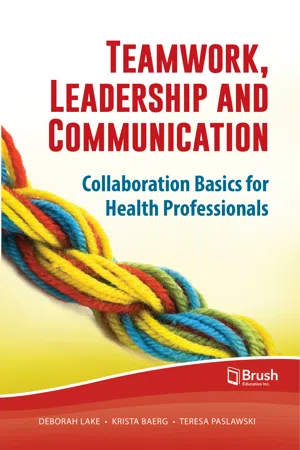
eBook - ePub
Teamwork, Leadership and Communication
Deborah Lake, Krista Baerg, Teresa Paslawski
This is a test
- 128 pages
- English
- ePUB (mobile friendly)
- Available on iOS & Android
eBook - ePub
Teamwork, Leadership and Communication
Deborah Lake, Krista Baerg, Teresa Paslawski
Book details
Book preview
Table of contents
Citations
About This Book
This practical, straightforward guide presents the basic skills, attitudes, and knowledge needed for successful interprofessional collaboration in healthcare. Collaboration is fundamental to quality healthcare, and many regulatory bodies and accrediting agencies now have standards and benchmarks for interprofessional collaboration. This guide brings together in one volume basic collaboration competencies for healthcare professionals.
Teamwork, Leadership and Communication serves both as an introduction for novices and as a refresher for experienced practitioners. It provides exceptional learning support for classes, working groups, and self-study. Topics include:
- Group dynamics
- Team structures
- Decision making
- Shared leadership
- Conflict management
- Communication in small groups
- Stereotyping
- Liability
Frequently asked questions
How do I cancel my subscription?
Can/how do I download books?
At the moment all of our mobile-responsive ePub books are available to download via the app. Most of our PDFs are also available to download and we're working on making the final remaining ones downloadable now. Learn more here.
What is the difference between the pricing plans?
Both plans give you full access to the library and all of Perlego’s features. The only differences are the price and subscription period: With the annual plan you’ll save around 30% compared to 12 months on the monthly plan.
What is Perlego?
We are an online textbook subscription service, where you can get access to an entire online library for less than the price of a single book per month. With over 1 million books across 1000+ topics, we’ve got you covered! Learn more here.
Do you support text-to-speech?
Look out for the read-aloud symbol on your next book to see if you can listen to it. The read-aloud tool reads text aloud for you, highlighting the text as it is being read. You can pause it, speed it up and slow it down. Learn more here.
Is Teamwork, Leadership and Communication an online PDF/ePUB?
Yes, you can access Teamwork, Leadership and Communication by Deborah Lake, Krista Baerg, Teresa Paslawski in PDF and/or ePUB format, as well as other popular books in Medizin & Medizinische Weiterbildung. We have over one million books available in our catalogue for you to explore.
Information
Topic
MedizinSubtopic
Medizinische Weiterbildung1 Introduction
Imagine working with a group of people who trust each other and share common goals. They know they can weather episodes of confusion or conflict — in fact, they understand that such episodes can lead to new understandings and result in decisions that everyone can support …
After readingthis chapter, you will be able to do the following:
- Define interprofessional collaboration in healthcare and distinguish collaboration from consultation
- Justify the central role of patient- and family-centered care in interprofessional collaboration
- Explain the rationale for collaborating in healthcare
- Map out a framework for understanding collaboration competencies and challenges in various contexts
Interprofessional collaboration has become a cornerstone of modern healthcare. Since collaboration is a social process, its course is not always smooth. To be efficacious, interprofessional collaboration requires participants who are willing, knowledgeable, and skilled, as well as settings that provide opportunities and resources. While settings vary, participants can transfer their attitudes, skills, and knowledge from one setting to another. Moreover, knowledgeable participants understand how the setting affects their collaboration and have the skills to adapt to different settings, especially when working collaboratively with patients and their families. Finally, mature health professionals understand that their competencies for interprofessional collaboration are continuously evolving.
Interprofessional Collaboration in Healthcare
Various models, definitions, and descriptions of interprofessional collaboration in healthcare (Canadian Interprofessional Health Collaborative, 2009; D’Amour & Oandasan, 2005; Way, Jones, & Busing, 2000; World Health Organization, 2010) point to the following essential components:
- A process for communicating and making decisions
- Shared goals
- The whole is more than the sum of its parts (synergy)
More specifically, “to collaborate is to create conversations in which people are joined together, meanings are fashioned, purposes are defined, roles are clarified, goals are established, and action is taken” (Seaburn, Lorenz, Gunn, Gawinski, & Mauksch, 1996, p. 9).

Review the following online resources to find models and definitions for interprofessional collaboration and interprofessional education:
American Interprofessional Health Collaborative: www.aihc-us.org/
Canadian Interprofessional Health Collaborative: www.cihc.ca/
Centre for the Advancement of Interprofessional Education (UK): www.caipe.org.uk/
Framework for action on interprofessional education and collaborative practice (World Health Organization, 2010): www.who.int/hrh/resources/framework_action/en/
What are some common threads among these organizations?
What resources may be especially useful for you and your setting?
In healthcare, collaboration and consultation are commonly used terms that are not interchangeable. Consultation is a process of seeking information from others in which the seeker integrates new information and generates a plan while retaining control of the process. In practice, the process of consultation becomes increasingly complicated as medical complexity increases and more professionals are involved. As a result, the patient may receive conflicting information or advice from different professionals. Collaboration, on the other hand, is characterized by joint goal setting and shared decision making and, when patient and family centered, with the patient and family as active participants. Effective collaboration results in shared understandings and plans supported by all participants.

Interprofessional collaboration is ideal but incredibly difficult!
Goals of collaboration in healthcare usually relate in some way to patient care, health, and well-being. Providing collaborative care to patients may be direct or indirect, as the following examples illustrate:
- Joint goal setting and care plan development for a hospitalized patient during bedside rounds
- A discharge-planning meeting with a hospital patient, community-based services, and family members
- A meeting to revise outdated patient-education handouts
- An ad hoc committee to organize in-service professional training
- A meeting between health professionals and school-based support services regarding a child with complex medical and social needs
- A research group working on a quality-improvement project
- A meeting with administration to respond to organizational policy changes that affect patient care
Professionals might be involved in several of these activities within the span of a few days. As Ho wrote in the Journal of Interprofessional Care, collaboration “is fundamental to the very fabric of the careers of health professionals” (2008, p. 1).
As health professionals, we may work with others from our own profession (intraprofessional collaboration) or from different professions (interprofessional collaboration). Working with individuals from other professions allows us to capitalize on the different perspectives each profession brings to the task. Just as we can see a visual illusion differently with the help of another person (see Figure 1.1), we can see a patient, problem, or task differently with the help of someone from a different profession. As the complexity of a patient, problem, or task increases, so does the need to incorporate multiple perspectives to ensure that this complexity is addressed.


Identify some other examples of situations or kinds of work that require health professionals to collaborate.
Is there a clear distinction between collaboration and consultation in these examples?
If not, how would you clarify expectations for your work?
Patient- and Family-Centered Care
Patient- and family-centered care is central to emerging models of collaboration in healthcare (Canadian Interprofessional Health Collaborative, 2009; D’Amour & Oandasan, 2005; Leathard, 2003). While patient- and...